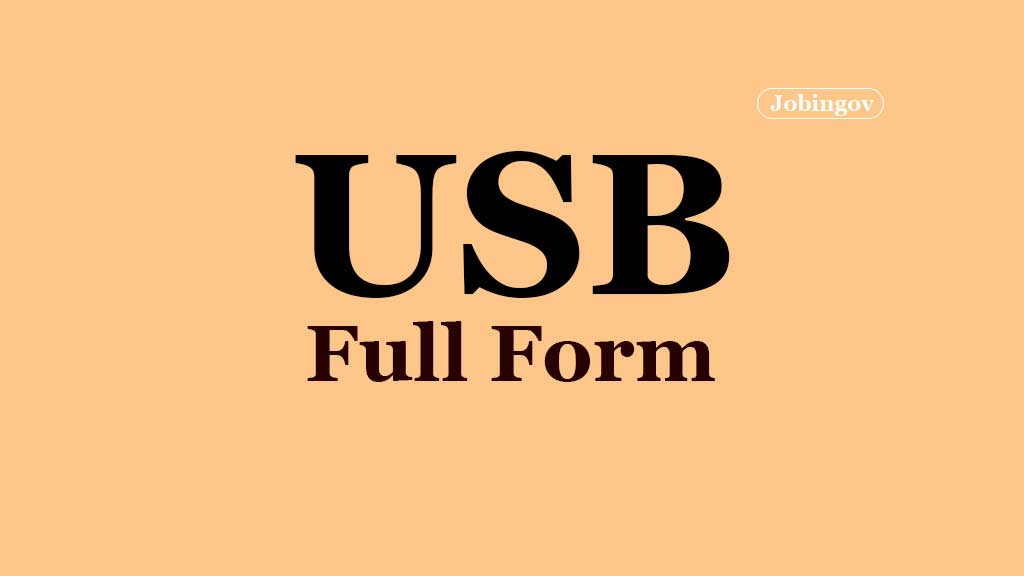What is the full form of USB?
The USB full form is the Universal Serial Bus. It acts as the common platform through which communication is done in between a device and a host controller like computer. It is very helpful to make link of computer with the electronic systems.
It is used for various purposes like power supply, contact, networking, data transfer, etc.

Universal Serial Bus is very useful and can easily be done the transfer of data as well as supply of electrical power in various peripheral devices like keyboards, mouse, printers, scanners, external hard drives, digital cameras, flash drives, external CD/DVD reader etc.
It also helps to reduce the consumption of power which acts as the best way to store data.
History of USB
In the year of 1994, seven companies made it possible to connect different devices with computers in a very easy way by working together. An Indian-American computer architect, Ajay V. Bhatt, was given the credit to develop USB who was working as the team leader and was a part of Intel.
In 1996, USB original version 1.0 was introduced. Microsoft, IBM, Compaq, Intel, DEC, NEC, and Nortel are the part of the group of companies whose collaboration help to develop USB. The developed USB was able to work in computers and laptops with certain speed. It can be used in various platforms like Windows, Linux, Mac, etc.
Before the introduction of USB, various devices were connected with the help of serial and parallel ports of computers to transfer data.
All the peripheral devices like keyboards, mouse, scanner, printers contain a unique port of its own. The major issue of these ports was the slow speed when connected to computers. The speed of data transfer between them was 120 kB/s to 500 kB/s.
Other than these problems, there are some other issues like incompatibility and multiple interfaces. That was the reason to develop USB to overcome these problems.
Types of USB
USB is the most used device for connectivity. Various number of USB ports is used in different devices. To work properly, you must have different types of USB. The creators had designed a number of USB to work comfortably.
You can find the use of USB cables almost everywhere and charging phones is the widest use of it. Types of USB cables used changed from device to device. In this section, different types of USB are discussed.
1. Type-A USB
The most used USB is of Type-A USB. We can find its application in computers, smartphones, cameras, keyboards, mouse and other devices of this kind. We can also find Type-A USB in most of the USB cables at one end.
2. Type-B USB
The use of this type of USB is very rare in a limited area. It connects an input device with printers and scanners.
3. Type-C USB
This is the latest standard of USB in modern technology which offer high rate of transfer with greater power as of earlier. It has many applications on laptops, smartphones etc.
4. Mini USB
This version of USB is now outdated and use is also very less especially for mobile devices. Micro-USB replaced the application of this type of USB but some device like MP3 players, cameras and other similar devices.
5. Micro USB
Micro-USB is smaller in size than mini USB. It has wide application in Bluetooth headphones, mobile phones, external packs etc.
Characteristic of USB
Some important characteristic of USB is given in the following points:
- Around 127 peripherals can be connected by using a USB host controller.
- With the advancement of technology, USB 3.0 is introduced having maximum 625 MB/s speed.
- It is found that the ‘plug and play’ mechanism is supported by the most of the USB devices. So, you don’t need to install additional software to run USB on the laptop or computer.
- Power saving mode is available in these USB devices in which sleep-mode is activated automatically after long time of idle.
- When USB devices are connected to a computer system, it consumes power from it without any additional supply of power. Such devices are mouse, keyboard, external storage devices etc.
Advantages of Using USB
- USB devices are comparatively less expensive to set up connection between devices.
- Everyone can use the USB devices for its ‘plug and play’ nature.
- Various type of USB connectors along with different size is easily available in the market.
- Power consumption of USB devices is very low.
- By using USB hub, length as well as number of USB ports are changed depending on the usage.
Disadvantages of Using USB
- USB cable’s length is not sufficient.
- An optimum speed is needed for some modern peripheral devices which is not available in the USB devices.
- You can use USB with certain limitations.
- At a certain time, only one message will transfer between devices.
- USB is not supported with broadcasting.
More Related Full Forms:
USB Full Form: FAQs
Q1. What is the full form of USB?
Ans: The full form of USB is Universal Serial Bus.
Q2. Who was given credit for the development of USB?
Ans: Ajay V. Bhatt who was an Indian origin architect given credit for the development of USB.
Q3. Which type of USB is used to connect scanners and printers?
Ans: Type-B USB is used to connect scanners and printers.
Q4. What is the use of USB?
Ans: USB is used to make connection between different peripherals like keyboards, mouse, scanners, printers, game controllers etc. Sometime it also acts as a charger.
Q5. Can audio be played using USB port?
Ans: There are some USB audio devices that enable us to play audio with proper configuration. Once you are able to install it properly then it will work smoothly.
Conclusion
USBs are the devices that are most used to build connection in different devices with laptop or computer. Most of the operating system supports this device to perform various operations.
We hope this article will help you to know the USB full form, history, types, characteristic, advantage, disadvantage, and more. For more posts like this visit Jobingov Blog and also follow us on Facebook and Twitter.





